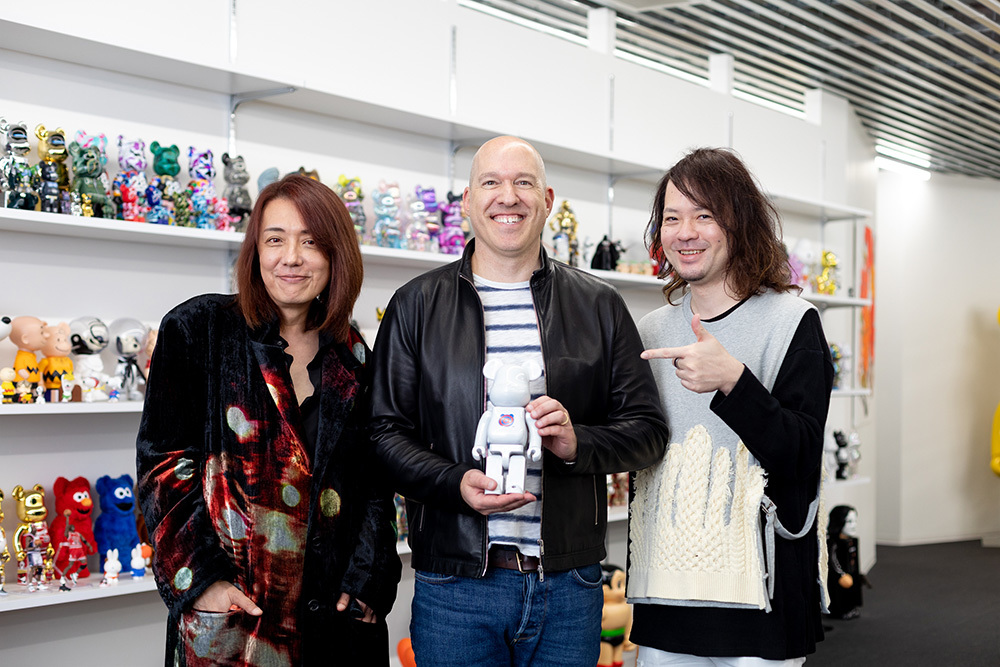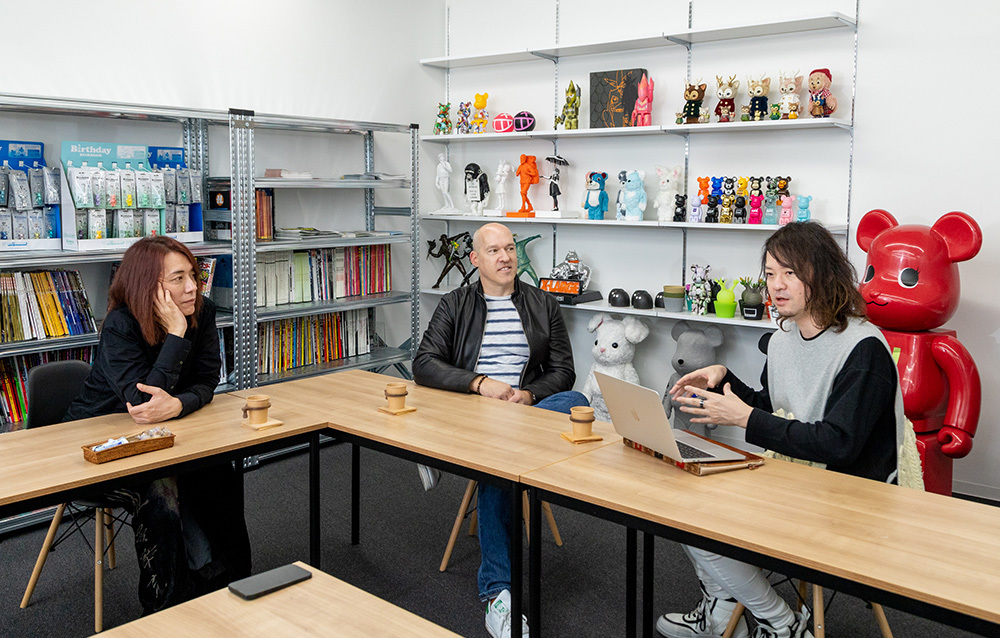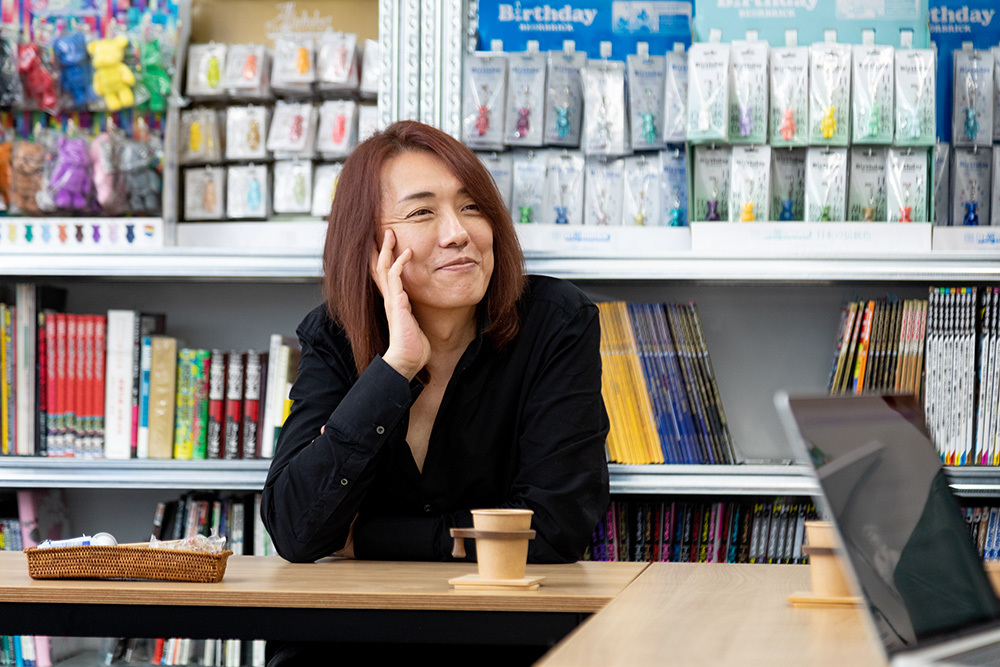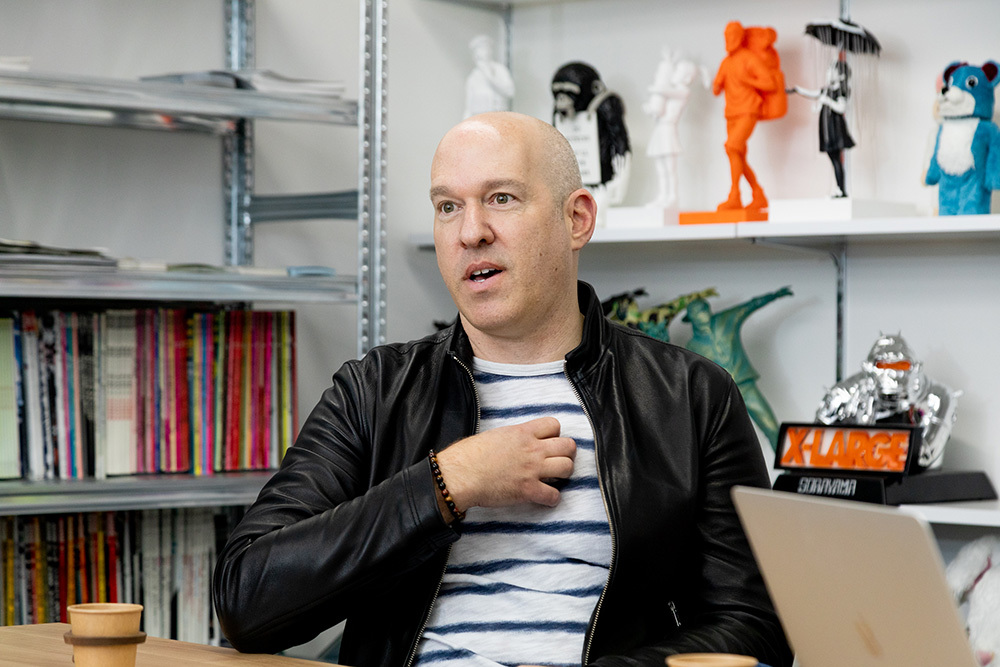BE@RBRICK, a Japanese figurine with passionate fans not only in Japan but around the world. An animated series based on this BE@RBRICK has been realized through a joint production between DreamWorks Animation (hereinafter DreamWorks), which has produced numerous global hit works, and Dentsu Inc.
How did the Japanese content "BE@RBRICK" achieve its global animation series adaptation? Ryuhiko Akashi, President of Medicom Toy and creator of "BE@RBRICK"; Peter Gal, Chief Creative Officer (CCO) at DreamWorks; and Tenpei Shikama, Content Creator at Dentsu Inc., share their insights.

From left: Mr. Akashi of Medicom Toy, Mr. Gal of DreamWorks, Mr. Shikama of Dentsu Inc.

Photo courtesy of Apple TV+
"BE@RBRICK" will be adapted into a 13-episode animated series featuring extensive CG animation. It is scheduled for release on Apple TV+ (March 21, 2025).
The ultimate simplicity of "BE@RBRICK" holds an appeal that resonates with Hollywood.
Shikama: First, let me explain how this project came to be.
Way back in 2016, a colleague of mine approached Mr. Akashi with the idea of turning "BE@RBRICK" into a globally distributed animated work, and he kindly agreed. Based on that, we approached DreamWorks, and the decision was made to create it together. From there, development took seven years, leading to production. Now, roughly ten years later, it's finally being released this year. It's truly deeply moving.
Looking back to the original impetus, there was Dentsu Inc.'s goal: "to create works that influence the world." I believe there are two types of works that influence the world. One pattern is "taking a country's unique cultural identity to its extreme." For example, "Departures" is a prime example of this highly successful approach.
The other pattern is "sharpening the quality of the work to the extreme" by smoothing out the edges, making it enjoyable for people of any cultural background. This pattern represents Hollywood's strongest traditional style, and I believe DreamWorks stands at its pinnacle. My initial spark was thinking that BE@RBRICK itself might embody this Hollywood style.
BE@RBRICK's popularity isn't confined to Japan; it's a figure deeply loved by people worldwide. When I ponder why, I think it's because it strips away decoration to achieve ultimate simplicity, possessing the flexibility to become any color. That's what I saw as its Hollywood-level, globally appealing charm.
Mr. Akashi, I'd like to ask you about your thoughts at the time. One reason many fans find BE@RBRICK appealing is its lack of narrative—the space it leaves for free imagination. Why did you deliberately choose to take it to the next level with animation?
Akashi: I got a call from a friend I'd known for ten years who was at DreamWorks at the time. He said he really wanted to make the BE@RBRICK animation project that Dentsu Inc. had proposed. I thought, if he's going to steer the project initially, I'll do it with him. That was the reason I took the plunge.
Shikama: Ah, so Dentsu Inc.'s proposal wasn't the reason (laughs). DreamWorks also immediately accepted the proposal, saying they wanted to do it! But what were your thoughts at the time, Peter?
Peter: When Dentsu Inc. showed me the "BE@RBRICK" concept, I'd seen them myself in stores around Los Angeles and knew they lacked narrative. Yet, for some reason, they had this emotionally compelling charm that stirred something in me. That's what drew me in.
To explain it, BE@RBRICK is fascinating because it's all uniform in construction, becoming a symbol that builds a community or world, yet each one is customized in design and has a unique personality. Instantly, I thought "Creativity and individuality" would be the core of this story. That's why I wanted to do it!
The Revolution Sparked by "BE@RBRICK" and the Theme Leading to the Work
Shikama: That work finally premieres on Apple TV+ starting March 21st. Without spoiling anything, can Peter tell us a little about what themes and story this work will explore?
Peter: The world in this work is fundamentally based on the idea that "you must obey state power and its rules." Here, upon graduating high school, your entire body is painted. This arbitrarily determines your profession and establishes your identity.
However, the main characters don't just passively accept being told by authority, "Become this face, become this profession." They have a desire to pursue what they want to do and to hold onto their individuality. So, the protagonists form a secret band. The band puts the message of "understanding your individuality and pursuing freedom" into their songs. It's a story about how that message, their music, and their activities change people's consciousness and ultimately change the world.
Shikama: Are there differences from other DreamWorks productions, or specific "passions" unique to BE@RBRICK?
Peter: Rather than differences, I believe there's an underlying core principle that's important, so let me talk about that.
What cemented DreamWorks' position in the industry was "Shrek." Shrek is a "challenger" who isn't perfect, and we value telling the stories of such challengers. The challenge of the "BE@RBRICK" protagonists changing the world with their message aligns with this core DreamWorks philosophy. BE@RBRIC isn't perfect either, right? Like having a bit of a belly. Those unique traits are what make them so wonderful.
Shikama: It's very important that the work shares themes aligned with the company's philosophy.
It might be presumptuous for me to say, but I feel BE@RBRICK sparked a revolution. It changed the world's perception – that it's okay for adults to like figures, and in fact, it's cool. As kids, we might love teddy bears, but as we grow up, we start thinking they're "childish" and leave that affection behind. But when I saw BE@RBRICK as an adult, I was struck: "Bears are cool!" "I want to display one in my room!" I think many people around the world felt that same shock.
I believe the revolutionary appeal of BE@RBRICK is directly and powerfully linked to this work.
Why? Because the main target audience for this work—elementary and junior high school students—are precisely at that moment of taking their first steps toward adulthood. It's a series aimed at these beginner adults, right at the time they might discard stuffed animals for nail polish, or ditch toys for skateboards—the very moment they might abandon bears.
For these young people, the message I learned from BE@RBRICK—that it's okay to love what you love, and you don't need to care about what society says—is embedded in this work. And I believe that connects directly to the core message of this work: "Become what you want to be, change the world."
Peter: And to add to that, you can repaint yourself whenever you want, whenever the time feels right. That's a really important point, isn't it?
Shikama: Exactly, just like life itself.

Both Peter and Akashi originally worked in completely different professions. They say they realized what they truly wanted to do, took action, and ended up where they are now.
Shikama: As the creator of BEARBRICK, how do you feel about the story and theme of this project, Akashi-san?
Akashi: I feel the theme of "becoming what you want to be" in this work is also fundamental to Medicom Toy as a company. We've always worked under the theme of "creating what we ourselves want." So it was incredibly meaningful.
Shikama: So this work carries a theme where the values DreamWorks holds dear and the values Medicom Toy holds dear intersect, right?
Japan's First Joint Production. What Matters is "Shared Understanding"
Shikama: It feels a bit odd for me to ask this myself (laughs), but I believe this is DreamWorks' first co-production with a Japanese company. How has the actual collaboration with Dentsu Inc. been?
Peter: Yes, this is our first such initiative. The success of a partnership hinges on shared goals and shared values, and we were fortunate to have that with Dentsu Inc. Having a solid shared understanding of the BE@RBRICK philosophy and worldview made progress incredibly smooth.
Shikama: We often act as intermediaries between original creators and production companies, and it's common for creative clashes to stall progress. But with this project, that truly never happened. Mr. Akashi, you show tremendous respect for the other party's creativity, don't you?
Akashi: That's right. Working with creators worldwide, we focus on how they express themselves on the canvas of BE@RBRICK and how freely they can expand their imagination within that expression. Our expectation of "What will they show us?" far outweighs any specific request like "Do it this way." The "dream" DreamWorks showed us this time was truly wonderful for me.

Peter: Throughout the process, we were always mindful of what Akashi-san and Shikama-san value most. We believe the most crucial thing is whether all partners can wholeheartedly agree and release the work into the world. If the story we created became Akashi-san's dream, nothing could make us happier.
Shikama: Amidst frequent clashes that could have caused things to fall apart, it was truly great that this project managed to move forward with the distinct visions of all three companies meshing well. It took time, though (laughs).
Peter: That's true (laughs). But actually, the extended timeframe had a positive side effect: it allowed more stakeholders and fans to become involved. For example, I believe the involvement of globally renowned music producer Timbaland was only possible because we took the time.
The Appeal of Japanese Content Seen Through the Times
Shikama: Finally, since we have the chance, I'd like to broaden the discussion a bit to Japanese content as a whole. Peter, beyond just BE@RBRICK, what potential do you see for Japanese content?
Peter: It depends on how globally appealing the content is, but I see two major possibilities. First, anime itself has gained global recognition, with a dramatically larger worldwide fanbase compared to the past. Second, content that was once wildly popular in specific regions, like Korean dramas, is now spreading globally thanks to streaming platforms. Looking at these trends, I believe much of Japan's content has a huge opportunity to expand worldwide.
Shikama: So you mean even Japanese content that previously couldn't reach the world has a chance now?
Peter: Yes. I saw the stage adaptation of "My Neighbor Totoro" in London, and both the actors and the direction were truly outstanding. I believe Japanese content, like Totoro, has the potential to be performed on stages worldwide. It's not just anime; music and various other forms of content could spread globally.
Shikama: It's true. Just a decade ago, it was unthinkable in America to watch foreign films with subtitles. But now, there's actually a growing audience that prefers to enjoy them in the original language. I'm genuinely surprised by how much things have changed in recent years.
From your perspective as someone who continues creating "BE@RBRICK," which has fans worldwide, what do you feel about the appeal of Japanese content?
Akashi: There are many different types of content around the world, but I feel Japanese works tend to have a bit more of a unique flavor. Because of that, some works struggle to break out of Japan, but there are so many that I wish could spread more widely across the globe.
Actually, regarding BE@RBRICK, I want it to be as "stateless" as possible. Looking at this series, I think it would be interesting if people from different countries all mistakenly thought, "This work is from my country." It's like a canvas where you can freely draw, so I deliberately avoid giving it a distinctly Japanese flavor.
Peter: That's fascinating. In today's world, people unconsciously create divisions. Amidst that, BE@RBRICK, stripped of gender, age, and even nationality, holds tremendous value.
When I ask collaborating artists and musicians why they partner with us, they say it's because of the "core humanity." I think BE@RBRICK allows you to feel that essential human quality.
Shikama: In terms of the current era, we strongly focused on being forward-looking and positive for this anime series. Amidst the pandemic and global instability, we wanted to steer things in a direction that lifts spirits, even just a little. But things might be different again in three years. I think it's crucial for creativity to keep updating, infusing it with the spirit of the times.
Peter: The beauty of characters is that once you breathe life into them, they start moving on their own. If this series reaches Season 2, I'm excited to see where the characters will take us.
Just as each of us individuals lives desperately with our own missions in life, the BE@RBRICK characters are also living desperately. I hope that aspect can spark a shared interest among everyone around the world.
Shikama: We hope many people will watch it, leading to a second and third series, a film adaptation, and the chance to see the characters' stories continue.
While finding a special source material like BE@RBRICK is rare, at Dentsu Inc., we want to discover source material with stories that connect to hope for people worldwide and continue creating and producing works together with DreamWorks.
About "BE@RBRICK":
Born in 2001, the 100th anniversary of the beloved teddy bear, this approximately 7cm block-type bear figure was created with the concept of "making a digital image teddy bear." Made with the rule of "designing solely through printing," adding nothing beyond the nine separate body parts. Resonating with this "limitless expressive potential" and captivated by its adorable form, BE@RBRICK has collaborated with numerous artists, brands, companies, and characters. It has continuously released thousands of items to the market, gaining many fans worldwide as an "art toy."












